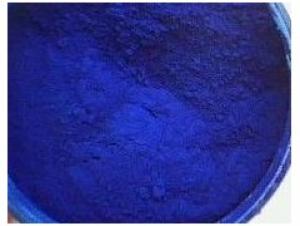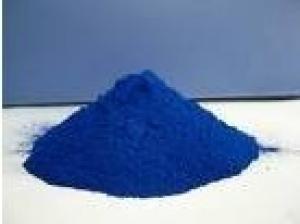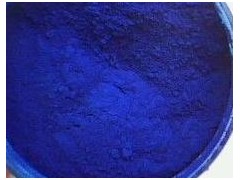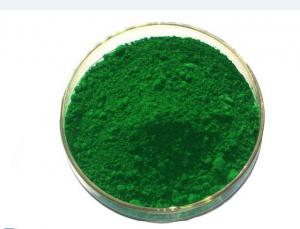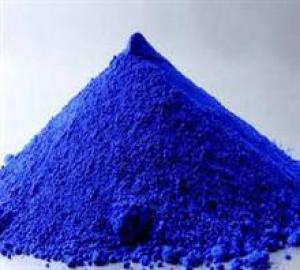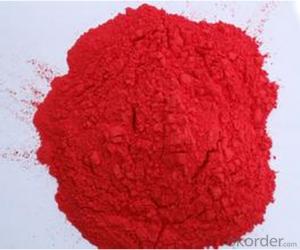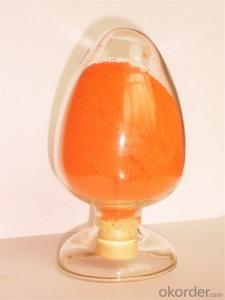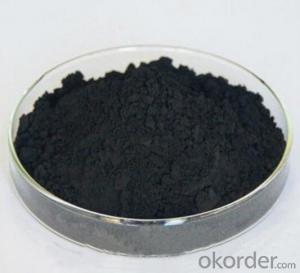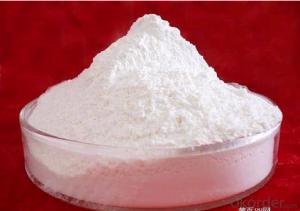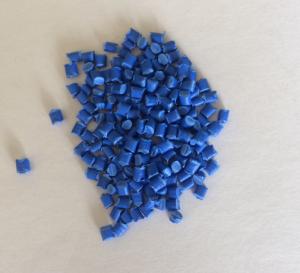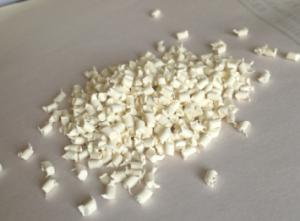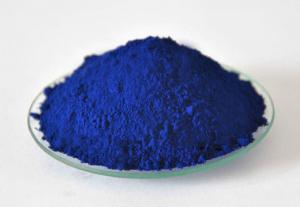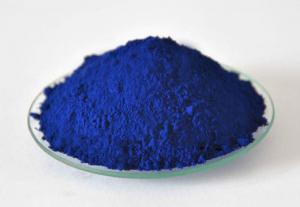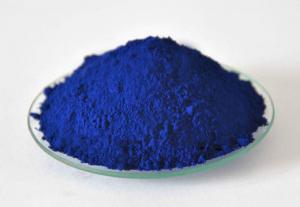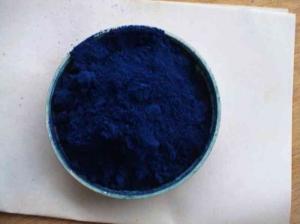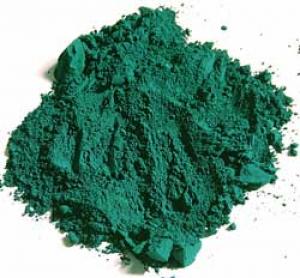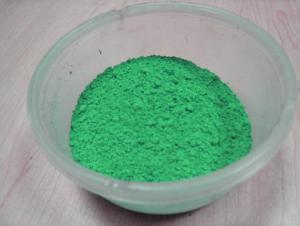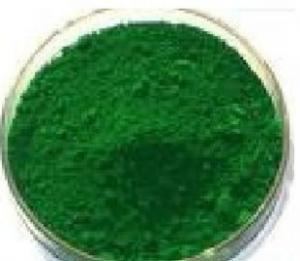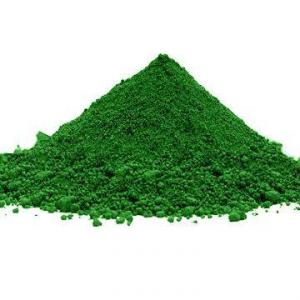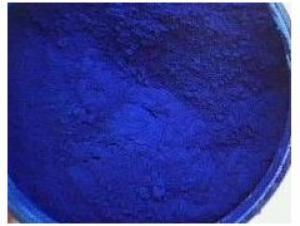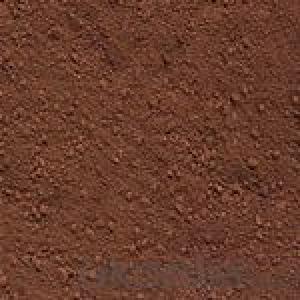Phthalocyanine Blue PB15:0
- Loading Port:
- Shanghai Port
- Payment Terms:
- TT or LC
- Min Order Qty:
- 1 Metric Ton m.t.
- Supply Capability:
- 7,500MT/Year m.t./month
OKorder Service Pledge
OKorder Financial Service
You Might Also Like
Phthalocyanine Blue FR6840
Product Specification | |||||
Chemical Structure | CuPc α | ||||
Color Index No. | PB 15:0 | ||||
Application | Ink | ||||
Physical Form | powder | ||||
| |||||
Test Items | Index | Test Method | |||
Relative Tinting Strength | 100 +_5% | DIN55986 | |||
ΔE,ΔL,Δa,Δb | ≤1,+1,+1,+1 |
| |||
| |||||
Items | Index | Test Method | |||
PH | 5.8~8 | DIN ISO 787-9 | |||
Density 20℃ g/cm3 | 1.6 | DIN ISO 787-10 | |||
BET m2/g | 66 | DIN 66131 | |||
Oil absorption g/100g | 35~45 | DIN ISO 787-5 | |||
105℃ Volatile Matter | ≤1.0% | DIN ISO 787-2 | |||
Water Solubles | ≤1.5% | DIN ISO 787-13 | |||
Residue on Sieve 100 mesh | ≤5% | DIN 53195 | |||
Conductivity us/cm | ≤300 | DIN ISO 787-14 | |||
| |||||
Solvent Resistance | Index | Test Method | |||
Water | 5 | DIN ISO 105-A03 | |||
White Spirit | 5 | DIN ISO 105-A03 | |||
| |||||
Tolerance | Index | Test Method | |||
Light Fastness | 8 | DIN ISO 105-A03 | |||
Weather Resistance | 5 | DIN ISO 105-A03 | |||
Acid Resistance | 5 | DIN ISO 105-A03 | |||
Alkali Resistance | 5 | DIN ISO 105-A03 | |||
Package of Phthalocyanine Blue :
25kg/ kraft bag or 220 kg into drum , or as your requirements .
Suggesting Using of Phthalocyanine Blue :
widely used in painting , ink , pigment and others.
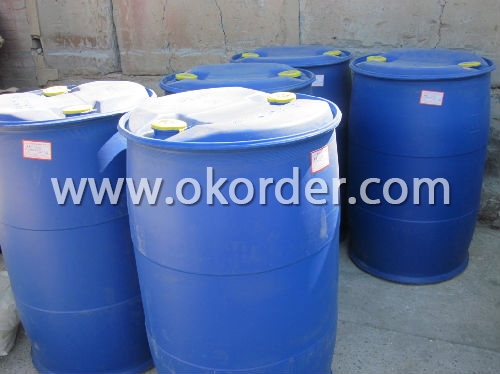

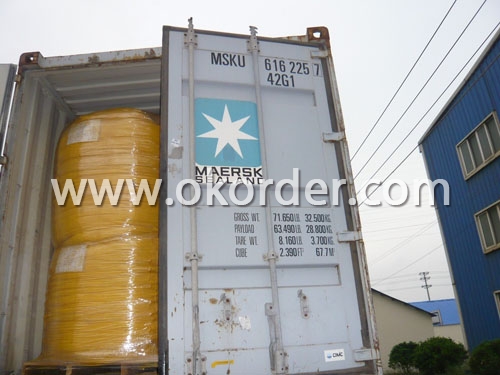
- Q: What are MAC eyeshadow pigments? Are they just like regular eyeshadow.. are they used the same way? Has anyone tried them and liked them?
- NEVER TRIED THEM HEARD GOOD THANGS THO
- Q: Can some one suggest chemical pigments that can be easily made from chemicals available in a chemistry lab for a project?I need the name of the pigment, reactants required and chemical equations of reactions involved.I need atleast 5 pigments
- Some pigments easy to make in a school laboratory: 1) Calcium carbonate: Mix solutions of calcium chloride and sodium carbonate : CaCl2(aq) + Na2CO3(aq) → CaCO3(s) + 2NaCl(aq) filter off and dry the calcium carbonate 2) Barium carbonate Exactly as above , but start with barium chloride 3) Calcium sulphate Mix solutions of calcium chloride and sodium sulphate: CaCl2(aq) + Na2SO4(aq) → CaSO4(s) + 2NaCl 4) Barium sulphate Use barium chloride instead of calcium chloride . 5) Satin white is another interesting pigment: Mix solutions of aluminium sulphate and calcium hydroxide with strong stirring , You get a paste which is a mixture of aluminium hydroxide and calcium sulphate . There is no specific formula because what you get depends on how you mix. Do not try and dry this out to get a dry pigment - it does not work. There are 5 white pigments that you can easily make - but remember to wear proper protective clothing when working with all chemicals
- Q: okay so I have always used all the cheap makeup and I am sick of it! I was wondering if mac pigments will give me a lot of color without having to use half of the container. Most eyeshadows look nothing like they are supposed to on me. they are like 100 times lighter. I have seen beautiful things done with the pigments but they look like they could get everywhere really easy. will they give me vibrant color without getting all over?
- *~...Welcome...It Won't Be Long Til U Become A MAC Addict. Hehe. Well Loose Eyeshadows Can Get Very Messy, So I Suggest Using A Primer Or An Eyeshadow Base When You Use The Pigments. The Pigments Will Last Longer And The Color Will Be More Vibrant. =) Trust Me, Once You've Tried MAC You'll Love It.... Also, If You Like The Pigments, May I Recommend Beauty From the Earth...They Have Great Color Selections It's Cheaper.... Enjoy!
- Q: I know the difference between the two, but which do you prefer? Which has a better color payoff? And, which do you own more of?
- pigments! they're only about 5 dollars more than an eyeshadow and there's so much in that little tub that it can last you forever! and the color payoff is a lot better. you can also use pigments for a lot more things, like mix it with clear lip gloss to make a really pretty lip shade, mix it with hair gel to put temporary color in your hair, or of course as eye shadow. and you could use it wet or dry depending on how intense you want your color i own more pigments than eyeshadows :]
- Q: What does it mean when something is highly pigmented?
- Pigment is color. When someone says something is highly pigmented it means that the color is bright or really vibrant. Hope this helped!
- Q: Does anyone know its chemical formula or constituents ?
- Epona's answer is extremely sturdy. in case you seem up colour institutions you will locate diverse institutions reckoning on who has written them and what structures they're drawing from. yet you'll be able to desire to continually use institutions that make experience to you. case in point - you will in all probability locate that easy blue is the colour linked with peace. yet reckoning on what form of peace you're going for you may go with a diverse colour. possibly purple if that is for peace in the kin or with acquaintances, pink if that is religious in nature, or eco-friendly if that is physique appropriate. The institutions I genuinely tend to circulate with are: pink - lust, action, means, braveness Orange - creativity, braveness, means (extra innovative form than the pink). Yellow - issues bearing on the concepts (like possibly you have have been given a attempt to earnings for) or psychological suggestion. easy eco-friendly - prosperity darkish eco-friendly - therapeutic easy Blue - peace, tranquility darkish Blue - desires, on occasion suggestion pink - issues coping with the religious White - purification and can be a stand in for extremely just about something Black - liberating negativity, banishing purple - love, friendship, kin i do no longer think there is any colour that would desire to be prevented. yet I often use a diverse affiliation than what i've got listed. And my institutions are in user-friendly terms valid for yet somebody else in the event that they make experience to them. i exploit white candles maximum many times as I continually have them handy and that they might continually be spiced up with diverse oils this is something I do very often.
- Q: wut is the diff between those 2?
- pigments are loose powder i believe. i like the eyeshadows better. there's a much better selection of those anyway.
- Q: i was thinking of this all day long and then i thought of posting this question for you to help me sort it out
- Pigments are molecules that absorb specific wavelengths (energies) of light and reflect all others. Pigments are colored: the color we see is the net effect of all the light reflecting back at us. Absorb: Electrons in molecules can exist at specific energy levels. Normally they exist at the lowest possible energy level they can. However, if enough energy comes along to boost them into the next level, they can absorb that energy and occupy that higher level. This is what pigments do. The light they absorb contains' just the right amount' of energy necessary to push them into the next level. Any light that does not have enough or has too much energy can not be absorbed and is reflected. The electron in the higher energy level, however, does not 'want' to stay there(i.e. it is unstable). It 'wants' to return to its normal lower energy level. In order to do this it must get rid or release the energy that has put it into the higher energy state to begin with. This can happen several different ways: 1) The extra energy can be converted into molecular motion and lost as heat. 2) Some of the extra energy can be lost as heat energy, while the rest is lost as light. This re-emission of light energy is called florescence. 3)The energy, but not the e- itself, can be passed onto another molecule. This is called resonance. 4)The energy and the e- can be transferred to another molecule. Plant pigments usually utilize the last two of these reactions to convert the sun's energy into their own. When chlorophyll is isolated from the enzymes it is associated with, the second scenario can be seen to happen.
- Q: What are the roles and type of plant pigments?
- Pigments are able to absorb specific wavelengths of light which power photosynthesis. Chlorophyll, which is green, absorbs all wavelengths except green. Each photon excites an electron in the light harvesting complexes of a photosystem in a chlorophyll molecule, eventually producing ATPs. Other pigments will be a different color and will be able to absorb other wavelengths, maximizing energy absorbency when the sun's rays change. Pigments are chemicals inside living things that absorb certain types of light. In plants, the pigment chlorophyll in leaves absorbs sunlight for photosynthesis to work, where the energy comes from. Chlorophyll absorbs all light except green, which is reflected. That's why most plants are green...
- Q: What is pigment?
- mac pigments are multi use. they're probably most popular as eyeshadows, but can also be used on lips, cheeks, nails, and pretty much anywhere. the mac pro store sells several mixing mediums, to change the consistancy of the powder, for the different uses, or they can be mixed with water/visine/etc.
1. Manufacturer Overview
| Location | Henan, China |
| Year Established | 1995 |
| Annual Output Value | Above US$100 Million |
| Main Markets | 20.00% North America 20.00% South America 10.00% Eastern Europe 10.00% Southeast Asia 10.00% Northern Europe 10.00% South Asia 10.00% Western Europe 5.00% Africa 5.00% Mid East |
| Company Certifications | REACH, ROSH,SVHC 53 Items Certificate ,SGS,CIQ,ISO9001:2008 |
2. Manufacturer Certificates
| a) Certification Name | |
| Range | |
| Reference | |
| Validity Period |
3. Manufacturer Capability
| a) Trade Capacity | |
| Nearest Port | Qingdao Port, China |
| Export Percentage | 51% - 60% |
| No.of Employees in Trade Department | 100 People |
| Language Spoken: | English; Chinese;Spainsh; Farsi;French;German |
| b) Factory Information | |
| Factory Size: | Above 600,000 square meters |
| No. of Production Lines | Above 3 |
| Contract Manufacturing | Design Service Offered; Buyer Label Offered |
| Product Price Range | Rock Bottom Price With Best Quality |
Send your message to us
Phthalocyanine Blue PB15:0
- Loading Port:
- Shanghai Port
- Payment Terms:
- TT or LC
- Min Order Qty:
- 1 Metric Ton m.t.
- Supply Capability:
- 7,500MT/Year m.t./month
OKorder Service Pledge
OKorder Financial Service
Similar products
Hot products
Hot Searches
Related keywords
